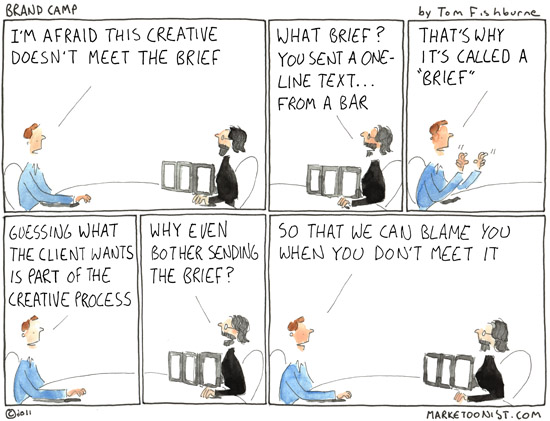
Currently, there is no standardised approach to writing an e-commerce brief.
You can write a brief focussed on the top-level information like business goals and values, or one closer to a full requirements specification detailing everything to the nth degree. Neither of these extremes are very helpful to the reader.
Using this guide will help you strike the right balance and make the process as easy and painless as possible.
I won’t lie, even using this guide and our time-saving tool, writing a good brief is going to take time and effort to complete.
So why put all of this time into writing a detailed brief?
- Peace of mind, knowing everything is considered
- Get more accurate proposals
- Save time in the long run
- Leads to a better specification and a better end product
- Easier to pick the right proposal & agency
- A more organised approach
Knowing exactly what information is required to create a solid brief can be difficult.
Below I will outline the sections you should include in your brief, along with what to include in each section, with examples to help you if you get stuck.
We have created a tool that will guide you through the brief creation process, providing you with a professionally produced brief to use.

About your business
In this first section, you will give an overview of your business to help the reader understand your company better.
You should aim for one to two paragraphs touching on some or all of the following, depending on what you deem to be appropriate.
- Brand
- Company values
- Size of company
- Turnover
- Ethos
- Summary of what company sells
- How you got started
- Where you are going, keep short as we will expand on this in later sections
If any of this is information is on your website, providing direct links is adequate.

Business goals & objectives
Don't outline website functionality, focus instead on what you're trying to achieve as a business.
Following on from above, you are going to flesh some of this out now by defining the business goals, objectives, problems and business requirements.
A reputable agency will want this to help them make sure they deliver the best solution. They might be able to offer alternative solutions that are better, but didn’t occur to you.
Try and aim for five main objectives
But give more if required, some examples are:
- Seamless / improved integration with other business systems
-
Increase KPI(s)
- Average Order Value (AOV)
- Number of average orders (per day / per month)
- Average Revenue per month
-
Reduce KPI(s)
- Bounce rate
- Abandoned carts
To see if you satisfy your objectives, ensure you have a way to track and report on all of the required data. Make sure you have a copy of all historical data if moving from an old system to a new system.
If you are exporting historical data, we recommend the following tools to store and quickly report on the data.

User Personas
Here you will give a little information about the people who will use your site.
Important note: this is not just customers, but also internal members of staff and maybe external companies like press, if appropriate.
Think about, who are your different types of customers and users, who are they, what are their needs? You don’t need to go into loads of detail, just enough of an overview for the reader to understand your users.

Competition
We were torn about adding this section, it’s a contentious issue in the business world in general.
Do you review what your competitors do, and aim to be “better”? Will this mean you end up imitating them and limit your innovation?
Are you better to ignore them altogether?
Where do you excel? Where do you fall behind the competition?
We are not going to answer these questions here, however, while you shouldn't thoughtlessly imitate your competition. It is good practice to know where your business sits within the competitive landscape, but don't aimlessly copy.
Some people might be tempted to skip this section, don't, it can still offer some insights.

Your Budget
Here we are at the second contentious point. Yes, your budget!
Many companies are very reluctant to give any indication of their budget. The fear is that the agency will write a proposal that will consume most of the budget, regardless of the actual cost of the job.
Understanding your budget allows the agency to come to an important conclusion. Is your budget appropriate?
If your budget is insufficient for any reason, maybe you're looking for too much development for your budget or the agencies day-rate is too expensive.
They can recommend alternative solutions such as:
- A SaaS self build.
- Another agency to help you out.
- Spread the cost with financing or phased billing.
- An agile project management approach, giving you a working solution, which might be missing a few bits of functionality. They can then develop these over time as you have more budget available.
- An interim solution using existing platform.

Discussing your Budget
Will save time for both you and your development agency.
The agency can also set your expectations because it's unlikely you will get a fully bespoke e-commerce website if you have a budget of £5,000.
Indicating your budget upfront allows an agency to propose the most appropriate solution, it also enables you to compare prices on a like for like basis if they are all working from the same spec and budget.
If you are not comfortable giving an exact figure or if you don’t currently have a budget, it is still useful to provide an estimate. Maybe part of the proposal process is so that you can give management an estimate of costs.
Whatever the case explain your situation as best you can, some examples are:
- We have a fixed budget of £11,250.
- We have a budget of £30-50k depending on the scope of the proposal.
- I am presenting this project to my boss and I am unsure of budget right now. However, our annual turnover is around £500,000.
- I am presenting this project to my boss and I am unsure of the budget right now. However, I expect the budget to be low tens of thousands.

People & Time
Give an overview of any deadlines you have for the project.
The could be a self-imposed deadline, one from senior management, customers pushing for change or mandated by law/regulatory body.
Outline key members of staff, including their availability for proposal and project duration. List who is responsible for the following, it could be the same person for multiple roles.
- Marketing
- Warehouse
- Fulfilment
- Admin
- Content/Product Merchandising
- Customer Service
- Management/Owners
- IT/Technical
On large e-commerce projects, it's wise to get input from the stakeholders from each department. They could have requirements that you may not be aware of and are best considered at the start of the project.
You don’t want to implement a system that doesn’t meet the requirements of each department, or makes someone's job harder without you realising. Miscommunication can also alienate parts of the business and cause internal issues.

State Assumptions
When writing a brief assumptions will be made, either consciously or subconsciously. It's easy not to state something because you deem it obvious, however, try to notice and document your assumptions. Some examples could be:
- Who will update the site
- Who’s responsible for making sure any stock images used can legally be used
- PCI compliance
- Security & SSL
- GDPR compliance
- Who will create marketing graphics
- Testing/Q&A/final sign off
- Responsibility for content, spelling/grammar/tone of voice
- Making sure site has relevant Metadata and alt tags
- Responsibility for image sizes (effects speed of pages)

Features
This section will constitute the bulk of your brief, it will form the backbone of the proposal and will list out all of the non-standard requirements you have. Standard items would mean things like add to cart and view order, you can skip those.
Thinking of everything that you might need to include can be a challenge, so we are creating a quick tool to guide you through the process and create a finished professional brief for you.
In the meantime, use the following headers as a guide.
Shipping
Everything that is needed to understand your shipping, such as what countries you ship to, shipping providers and do you offer free shipping.
Template & navigation
Do you have any particular requirements for the setup of the site's navigation? Any requirements for editing the look and feel of the site?
Lists
Do you need wishlists, saved baskets or favourite lists for example? Do you want people to be able to share them as public lists?
3rd Party systems
What external systems does your e-commerce system need to work with? Some examples are PIMS, stock control systems, ERP and CRMs.
3rd Party tools
What other tools do you use for analytics, newsletters, marketing and personalisation?
Blog
Do you need a blog, if so what features do you need?
Site Type
Is your site business to consumer (B2C), business to business (B2B) or direct to consumer (D2C)?
B2B
What specific B2B features do you need if any?
Promotions / Codes / Discounts
What promotions and discount code requirements do you have, anything specific or custom?
Affiliates / referrals / loyalty points
Do you have an affiliates or referrals system, or need one adding to the site? If you require some form of loyalty point scheme?
Purchase & checkout process
If you have any specific purchase requirements, such as "make an offer" or if you require the checkout process to have specific functionality, then mention that.
Products & Product page
Do you need particular attributes/information on the product page or need it to function in a specific way? How many products do you have?
Payments
What payment options do you want and what gateway/merchant account do you use?
Internationalisation
Do you want to internationalise your site, translate the language or take payment in different currencies?
Reviews
Do you want to be able to show company reviews on the site, or incorporate product reviews? Do you use an external system already?
Admin
Do you need to be able to set user roles and permissions or have workflows and sign off for changes and updates?
Hosting
Who will be hosting the site, if self-hosted, where will you host?
Customer support
Do you use a support desk, if so do you need to be able to link it up with your e-commerce site?
Migration
If you are migrating, what info do you need to move over to the new site?
Emails
List all of the emails that you need, including transactional and marketing based ones.






